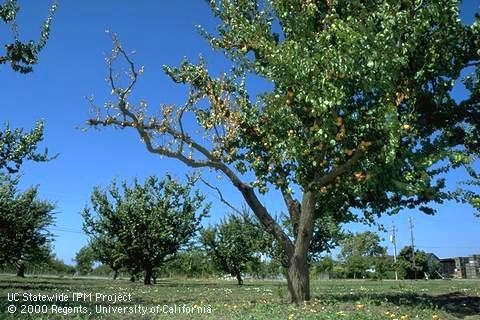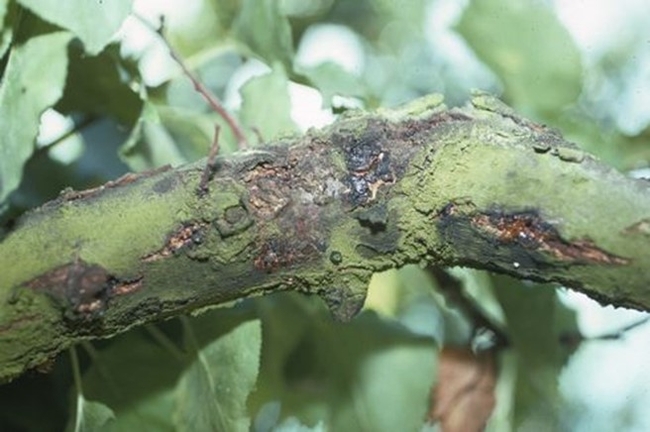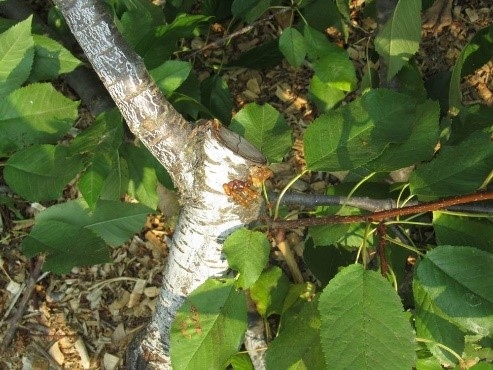Prune Apricot and Cherry Trees in August
If you have apricot, cherry, or related hybrid tree varieties such as aprium and pluot in your yard, plan to prune them before the end of August. This timing will help prevent infection by a deadly fungal disease called Eutypa Dieback that can kill these trees as well as grape vines.
When infected by Eutypa, branches or entire trees wilt and die suddenly, often with the leaves still attached.
Apricot tree with branch killed by Eutypa
Signs that your tree may be infected by Eutypa include darkly discolored cankers on the branches and oozing of amber colored gummy sap.
Eutypa cankers on apricot branch
Oozing Sap on Cherry Tree from Eutypa Infection
[Editorial Note: apricot photos downloaded from UC Repository. Cherry tree photocopied from UC ANR blog article by Chuck Ingels, UCCE Sacramento, https://ucanr.edu/blogs/blogcore/postdetail.cfm?postnum=16014 ]
Many other varieties of trees and shrubs can become infected with the Eutypa fungus without showing disease symptoms or progressing to the dieback stage. These other tree and shrub varieties can serve as store houses for the Eutypa pathogens that could potentially spread to your grape vines and apricot, cherry, aprium and pluot trees. Trees and shrubs that can serve as reservoirs for the disease include almond, apple, blueberry, crabapple, honeysuckle, kiwi, oleander, pear, and certain native plants such as big leaf maple, California buckeye, ceanothus, and willow.
Eutypa disease is spread from an infected tree, shrub or vine to uninfected trees by splashing water from sprinklers or rain. The splashing water allows the fungal spores to enter through pruning or other wounds. Pruning vulnerable tree varieties by the end of August allows pruning wounds to heal and close before the typical start of the rainy season in Contra Costa County in late October. Also, avoid using sprinklers near recently pruned trees since water from sprinklers can also spread infections. Using these precautions will reduce the risk of infection for your trees.
Studies have shown that the Eutypa pathogens can also be spread on pruning tools that have been used to prune infected trees and shrubs. To prevent such transmission, be sure to disinfect your pruning tools before and after pruning.
To disinfect tools, soak them for thirty minutes in a 10% bleach solution (nine parts water to one part bleach). Bleach is corrosive so be sure to rinse the tools thoroughly with water after soaking. Then oil them. The bleach solution loses 50% of its effectiveness after two hours, so be sure to use a freshly mixed batch.
As an alternative to bleach, you can disinfect pruning tools with 70% isopropyl alcohol. Just spray it on your tools and it will kill any pathogens almost immediately. Alcohol is not corrosive, so you don't need to rinse it off tools.
An internet search for “how to prune apricot [or cherry, aprium or pluot] trees” will help you find videos that demonstrate good pruning techniques. Just be aware that most pruning videos are filmed when the trees are dormant. With no leaves, the branches can be more easily shown in the video to demonstrate pruning techniques. In California, you don't want to wait until the dormant season to prune these vulnerable trees because that increases the risk of an Eutypa infection. So, you'll need to adapt the pruning techniques to a tree that still has leaves.
For more information on Eutypa disease, visit this University of California IPM website: http://ipm.ucanr.edu/PMG/GARDEN/FRUIT/DISEASE/eutypadieback.html


